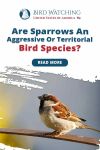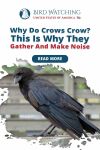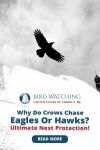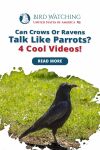
What’s This Post About?
A sparrow or a house sparrow is a small songbird, found abundantly in North America. It is known to be one of the most widely distributed birds globally. There has been seen a decline in these birds for several decades now, due to the changing environment across the world.
This post consists of everything you need to know about house sparrows and their nature. By the end of this post, you will be able to identify a house sparrow and take the necessary precautions that are required to avoid the problematic side of these species.
House sparrows are not territorial. The only territory the male sparrow defends is the nesting hole. However, these tiny birds are very aggressive. They attack, harass, and kill other adult birds if they intrude on their nest sites. Sparrows may also destroy the eggs of other birds

What Are House Sparrows?
If you are not aware of what a house sparrow looks like or its lifestyle, the following information will guide you.
House sparrows are small songbirds, found commonly in many countries. There are various kinds of sparrows, but the house sparrow is the most familiar one in North America. They can be described as little brown birds, hopping across urban cities.

The sparrows were first found in England where they were welcomed to help them get rid of insects and other pests. However, with time they became a nuisance.
The house sparrow population started growing rapidly at very alarming rates. So much so that the birds became a threat to crops and fruit trees.
These birds also aggressively took over other nesting sites and drove the native birds away, which was a loss for the country. Let’s dive deep into the nature of a house sparrow.
Pro-Tip
It is better to avoid keeping nest boxes for house sparrows, they may cause damage to your backyard.
1. Identification
House sparrows are small birds with a stout bill that helps them feed on seeds. They have a scruffy and shabby appearance with a dull plumage.
Adult male sparrows have a grey nape and crown. Both sides of their head are brown, and they have a black bib-like feature on their chest. The back of the adult males is of a warm brown tone with streaks of black and white on them.
Adult females and young sparrows are usually sandy browns with grey, black, and brown streaks on their back and wings area.

Fun Fact
Sparrows are very small; they are 4 -8 inches long and weigh approx. 0.8-1.4 ounces.
2. Lifestyle
The breeding season for house sparrows begins in the early spring season or the midwinters. The pairs produce approximately four broods per season. The male sparrows are extremely aggressive when it comes to defending their nesting site.
House sparrows prefer nesting in tree cavities or evergreens. They may also take over nests of Northern Orioles or Swallows and stay there.
These birds are not migratory but may move in flocks up to 2 to 5 miles from their area. If we talk about their eating habits, they primarily feed on seeds. The female sparrows may also feed on insects while raising their young.

Moreover, house sparrows may feed on garbage lots or farmlands which is why they are often seen near malls, stores, and even restaurants.
Fun Fact
A male house sparrow is more protective about his nesting site than his mate; he may lose his mate, but he will not let anyone take up his nest site.
3. Nesting
The house sparrows are quick with building their nests. They bring together coarse grasses, weeds, feathers, and trash to make their nest.
The female house sparrow lays 3 to 8 eggs per brood. The eggs are of a white and green shade with brown speckles on them. The incubation period lasts for 11 to 13 days, and the juvenile sparrows transition into fledglings 14 to 17 days after that.
Fun Fact
Sparrows produce 2 to 4 broods in a year.
What Are the Problems Caused by House Sparrow’s Aggressive Nature?
These aggressive birds can create a lot of chaos, keep reading to learn about the problems they bring with them.
House sparrows bring with them many problems for other native birds. These problems include killing other birds’ eggs, competing for nests, driving away other birds from food sources, etc.

The problems created by house sparrows need to be dealt with in the long run. It is best to not welcome these sparrows to your yard for permanent residents as it will not only cause damage to your backyard but also drive other pretty birds away.
The most vulnerable birds that cannot bear the sparrow’s aggressiveness are:
-
Orioles
-
Cliff and Tree Swallows
-
Eastern Bluebirds
-
Western Bluebirds
-
Purple Martins
These birds are in direct competition with the sparrows as they share similar interests in food and nesting sites.
Fun Fact
Utilize boxes and feeds that are specially designed for the preferred species you wish to attract.
1. Competing With Other Birds

Sparrows tend to takeover birdhouses and feeders that are hung for other native birds. They are fierce and aggressive, so they are often successful in driving other native birds away from the nesting sites.
House sparrows are very defensive when they find a particular food source. If they find other birds near the food source or feeder, they may bully them or even kill them.
Fun Fact
Sparrows prefer nesting near buildings, to avoid them you can hang birdhouses away from buildings.
2. Nesting Near Buildings
House sparrows are noisy creatures. They prefer nesting near buildings that may irritate the residents of a particular building. The loud chirping can cause sleep disturbances as sparrows tend to sing at the very first morning light.
Secondly, house sparrows store their nesting material in vents, dryers, or stoves which may make it difficult for people to use them. This becomes a serious problem.
You can consider exploring covers for vents to keep them protected.
Magnetic Vent Cover
The vent covers are three times thicker than normal vent covers in the marketplace
How To Get Rid of Aggressive Sparrows?
Where problems occur, it becomes important to find solutions to overcome them.

If you are fed up with sparrows in your yard and are determined to make the life of other native birds easier, you should take certain precautions that will ensure safety from these birds. Discouraging house sparrows to enter your backyard will help eliminate the problems that come with them.
You can also keep a check on your backyard by watching the birds that are visiting your yard. If sparrows are no longer seen, this means these tips and tricks have successfully worked.
To learn the basics of birdwatching, you can also read this post to make the most of your birdwatching experience.
Backyard Bird Watching Essential Gear for Beginners - Fantastic & Amazing Guide
Are you interested in knowing what could make your bird-watching experience enthralling? Read on to find out about the essential gear you need to own.
1. Change Feeders
There are different types of feeders that you can hang in your yard. House sparrows usually prefer feeding on the ground or a large platform. You can remove large feeders that are placed on the ground. This will discourage the sparrows from visiting your yard.
Instead, you can purchase a clinging mesh feeder or tube feeder that helps attract other harmless native birds.
The perches should be shorter than 5/8 inch to avoid house sparrows from perching on them. Taking this step will filter your yard of all aggressive sparrows.
Pro-Tip
Clean up any spilled seeds so that sparrows do not find any food source on the ground.
2. Do Not Re-fill Food Items Preferred by Sparrows
Getting rid of food sources that are loved by sparrows will be a big step towards eliminating house sparrows from your yard. Examples of food that you should remove from the feeders are:
-
Sunflower seeds
-
Millet
-
Cracked corn
-
Oats
-
Bread/wheat
These food sources can be completely removed or restricted to small feeders only so that it does not attract any house sparrows. Food sources that aggressive birds do not prefer are:
-
Nyjer
-
Fruits
-
Suet
-
Nectar
-
Safflower seeds
-
Nuts
The above-listed items can be kept in the feeders as they do not fall under the preferred feed of house sparrows.
Pro-Tip
Hang feeders high up in the trees as swaying feeders scare the sparrows away.
3. Remove Birdbaths

House sparrows love to visit birdbaths for bathing and drinking. To avoid house sparrows, you may need to displace birdbaths or basins from your yard so that the house sparrows are discouraged to visit your yard completely.
However, to provide water to other small birds, you can install drippers or other small hanging drinking jars. It is also important that you evaluate gravel areas in your yard and cover up all dusty patches that the sparrows might use for dust baths.
Pro-Tip
Use nest boxes and birdbaths that are specifically created for other small bird species.
4. Reduce Shelter Availability
House sparrows look for shelter in closed spaces such as near buildings, sheds, etc. They can adapt to a wide range of locations which is why it will be difficult to remove all sheltered places from a backyard.
For safety, it is recommended to keep all sheds and garage doors closed. This will prevent the birds from entering your residential premises. Roosting boxes should be avoided as sparrows will try to claim territory over these boxes.
Pro-Tip
Install mesh under a house’s eaves as it will prevent sparrows from roosting in the protected areas.
5. Remove Nesting sites
The fact that house sparrows are extremely aggressive is established by now. They compete with other native birds and may even end up killing or injuring them. To prevent this from happening, a timeline should be followed.
Birdhouses should not be hung up before 01 April. House sparrows usually begin searching for nesting sites in February or March. In this period, other birds have not yet arrived in their breeding range.

You can always hang up birdhouses that are made with PVC pipes as sparrows do not like to reside in those. Sparrows prefer wooden houses to nest in.
Pro-Tip
Make the entrance hole of the birdhouses smaller so that sparrows cannot enter.
Conclusion
House sparrows that were once commonly found in many regions are now rare to find. In this post, we covered how house sparrows are extremely aggressive small birds that chase away other native species with their bullying nature.
It requires a lot of effort to prevent house sparrows from entering and settling in your yard. They bring with them problems and these problems need to be dealt with instantly. You could utilize the ways discussed to discourage these aggressive birds from visiting your yard.
If you want to capture some more beautiful songbirds on your phone or through professional equipment, consider reading this post.
Backyard Bird Photography: Essential Gear for Beginners - Here is Your Expert & Exciting Guide!
Here’s your expert and exciting guide to set you on course for a captivating photography experience. Backyard bird photography just got better, learn how!

By David A. Swanson
Bird Watching USA
My name is David and I'm the the founder of Bird Watching USA! I started Bird Watching with My father-in-law many years ago, and I've become an addict to watching these beautiful creatures. I've learnt so much over about bird watching over the years that I want to share with the world everything I know about them!

David A. Swanson
Bird Watching USA
My name is David and I'm the the founder of Bird Watching USA! I started Bird Watching with My father-in-law many years ago, and I've become an addict to watching these beautiful creatures. I've learnt so much over about bird watching over the years that I want to share with the world everything I know about them!












